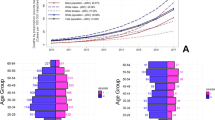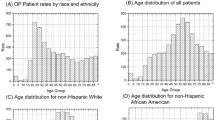Abstract
This study investigates the trend of spatial distribution and characteristics of ketamine users in China during 2010–2015 based on China’s National Surveillance System on Drug Abuse (NSSDA). A total of 28,670 ketamine users registered during the study period, and reported cases increased from 3192 in 2010 to 6878 in 2014, and dropped back to 4895 in 2015 (APC = 13.9, 95% CI: − 0.3 to 30.1, p = 0.1). Spatial distribution analyses at provincial level showed that regions with high report rate were clustered in southern China around Guangdong, and trends of spread into inland areas were observed. The proportion of new users, which reflected the relative growth of ketamine prevalence, increased from 6.27 to 12.34% over the study period (p < 0.001). Besides, the odds of being new users were higher among migrant users (also known as “floating population” in China) compared with local registered users. Our study verifies a significant association between floating population and ketamine spread, which calls for further investigation.




Similar content being viewed by others
References
Acharya, B. K., Cao, C., Xu, M., Chen, W., & Pandit, S. (2018). Spatiotemporal distribution and geospatial diffusion patterns of 2013 dengue outbreak in Jhapa District. Asia Pacific Journal of Public Health, 30, 396–405.
Anderson, A. F., Qingsi, Z., Hua, X., & Jianfeng, B. (2003). China’s floating population and the potential for HIV transmission: A social-behavioural perspective. AIDS Care, 15, 177–185.
Chen, W. J., Ting, T.-T., Chang, C.-M., Liu, Y.-C., & Chen, C.-Y. (2013). Ketamine use among regular tobacco and alcohol users as revealed by respondent-driven sampling in Taipei: Prevalence, expectancy, and users’ risky decision making. Journal of Food and Drug Analysis, 21, S102–S105.
Cheng, W.-C., & Dao, K.-L. (2017). The occurrence of alcohol/drugs by toxicological examination of selected drivers in Hong Kong. Forensic Science International, 275, 242–253.
Cheng, W.-C., & Dao, K.-L. (2019). Prevalence of drugs of abuse found in testing of illicit drug seizures and urinalysis of selected population in Hong Kong. Forensic Science International, 299, 6–16.
Copeland, J., & Dillon, P. (2005). The health and psycho-social consequences of ketamine use. The International Journal on Drug Policy, 16, 122–131.
Degenhardt, L., & Dunn, M. (2008). The epidemiology of GHB and ketamine use in an Australian household survey. The International Journal on Drug Policy, 19, 311–316.
Dillon, P., Copeland, J., & Jansen, K. (2003). Patterns of use and harms associated with non-medical ketamine use. Drug and Alcohol Dependence, 69, 23–28.
Feng, L.-Y., Yu, W.-J., Chang, W.-T., Han, E., Chung, H., & Li, J.-H. (2016). Comparison of illegal drug use pattern in Taiwan and Korea from 2006 to 2014. Substance Abuse Treatment Prevention and Policy, 11, 34.
Gao, X., Den, J., Huang, Ji., & Huang, G. (2016). Analysis of ketamine abuse among Guangdong new substance-abusers from 2010 to 2014. Chinese Journal of Drug Dependence, 25, 119–123.
Hsu, J., Lin, J.-J., & Tsay, W.-I. (2014). Analysis of drug abuse data reported by medical institutions in Taiwan from 2002 to 2011. Journal of Food and Drug Analysis, 22, 169–177.
Huang, W., Operario, D., Dong, Y., Zaller, N., Song, D., He, H., et al. (2014). HIV-related risk among female migrants working in entertainment venues in China. Prevention Science, 15, 329–339.
Ifeng News. (20130. There are a total of 680 compulsory isolated detoxification centers in China. Available at: http://finance.ifeng.com/roll/20130105/7516242.shtml (Accessed on Mar. 30, 2020).
Jia, Z., Liu, Z., Chu, P., McGoogan, J. M., Cong, M., Shi, J., & Lu, L. (2015). Tracking the evolution of drug abuse in China, 2003–10: A retrospective, self-controlled study. Addiction, 110, 4–10.
Jin, Y., Liu, Z., Fan, C., An, X., Jia, Z. (2015). A spatial-temporal analysis of ketamine abuse in China. International Journal of Symptoms in Ketamins Abusement Prevention Control.
Joe-Laidler, K., & Hunt, G. (2008). Sit down to float: The cultural meaning of ketamine use in Hong Kong. Addiction Research and Theory, 16, 259–271.
Johnston, L. D., Miech, R. A., O’Malley, P. M., Bachman, J. G., Schulenberg, J. E., Patrick, M. E. (2019). Monitoring the future national survey results on drug use 1975–2018: Overview, key findings on adolescent drug use. Ann Arbor: Institute for Social Research, University of Michigan. Available at: https://files.eric.ed.gov/fulltext/ED594190.pdf (Accessed on Mar. 30, 2020).
Jongenelis, M., Pettigrew, S., Lawrence, D., & Rikkers, W. (2019). Factors associated with poly drug use in adolescents. Prevention Science, 20, 695–704.
Lim, D. K. (2003). Ketamine associated psychedelic effects and dependence. Singapore Medical Journal, 44, 31–34.
Liu, Z., Gong, X., Zhou, M., & Wang, Z. (2014). Research report on ketamine abuse problem in China. Chinese Journal of Drug Dependence, 23, 321–323.
Liu, Z. (2016). Ketamine abuse and its consequence for public health and social problems. Chinese Journal of Drug Dependence, 25, 2–10.
Meng, L., Li, J., Lu, Y., Sun, D., Tao, Y.-X., Liu, R., et al. (2015). Ketamine - A multifaceted drug. Translational Perioperative and Pain Medicine, 1, 20–26.
Morgan, C. J. A., & Curran, H. V. (2012). Ketamine use: A review. Addiction, 107, 27–38.
Narcotics Division (2019). Central Registry of Drug Abuse Sixty-seventh Report. Hong Kong. Available at: https://www.nd.gov.hk/pdf/report/crda_67th/67th%20CRDA%20Report%20(full%20version).pdf (Accessed on Mar. 30, 2020).
National Bureau of Statistics (2020). 2019 Statistics Bulletin of the National Economic and Social Development of the People’s Republic of China. Available at: http://www.stats.gov.cn/tjsj/zxfb/202002/t20200228_1728913.html (Accessed on Mar. 30, 2020).
National Institute on Drug Abuse Monitoring Centre. (2016) Annual Report on Drug Abuse in China 2016. Beijing, China: National Institute on Drug Abuse Monitoring Centre, National Institute on Drug Dependence of Peking University. Available at: http://samr.cfda.gov.cn/WS01/CL0844/175994.html. (Accessed on Mar. 2, 2020).
National Medical Products Administration. (2019). Notice on strengthening surveillance on drug abuse, Beijing. Available at: http://www.cdr-adr.org.cn/drug_1/zcfg_1/zcfg_zdyz/201911/t20191101_46706.html. (Accessed on Mar. 30, 2020).
National Narcotics Control Committee (2014). Report of the Chinese drug situation in 2014, Beijing. Available at: http://www.nncc626.com/201506/24/c_127945747.htm. (Accessed on Mar. 30, 2020).
National Narcotics Control Committee. (2018). Annual Report on Drug Abuse in China 2016, Beijing. Available at: http://www.nncc626.com/2018-06/04/c_129886311.htm. (Accessed on Mar. 30, 2020).
National People’s Congress Standing Committee. (2007). The Law Against Drug Abuse and Illicit Trafficking of the People’s Republic of China. Beijing, China: National People’s Congress Standing Committee.
NCAIDS., NCSTD., China CDC. (2015). Update on the AIDS/STD epidemic in China and main response in control and prevention in December, 2014. Chinese Journal of AIDS and STD, 21(2), 87.
Nemoto, T., Iwamoto, M., Perngparn, U., Areesantichai, C., Kamitani, E., & Sakata, M. (2012). HIV-related risk behaviors among kathoey (male-to-female transgender) sex workers in Bangkok, Thailand. AIDS Care, 24, 210–219.
Nickerson, J. W., Attaran, A. (2015). The Commission on Narcotic Drugs’ attempt to restrict ketamine. Lancet, 385, e19.
Pal, R., Balt, S., Erowid, E., Erowid, F., Baggott, M. J., Mendelson, J., et al. (2013). Ketamine is associated with lower urinary tract signs and symptoms. Drug and Alcohol Dependence, 132, 189–194.
Ravn, S., & Demant, J. (2012). Prevalence and perceptions of ketamine use among Danish clubbers: A mixed-method study. Nordic Studies on Alcohol and Drugs, 29, 397–412.
Sassano-Higgins, S., Baron, D., Juarez, G., Esmaili, N., & Gold, M. (2016). A review of ketamine abuse and diversion. Depression and Anxiety, 33, 718–727.
Shek, D. T. L. (2007). Tackling adolescent substance abuse in Hong Kong: Where we should and should not go. Scientific World Journal, 7.
Home Office. (2019). Drugs misuse: Findings from the 2018/19 Crime Survey for England and Wales. Available at: https://assets.publishing.service.gov.uk/government/uploads/system/uploads/attachment_data/file/832533/drug-misuse-2019-hosb2119.pdf (Accessed on Mar. 30, 2020).
UNODC. (2019). World Drug Report 2019. Vienna. Available at: https://wdr.unodc.org/wdr2019/prelaunch/WDR19_Booklet_5_CANNABIS_HALLUCINOGENS.pdf (Accessed on Mar. 30, 2020).
Uosukainen, H., Tacke, U., & Winstock, A. R. (2015). Self-reported prevalence of dependence of MDMA compared to cocaine, mephedrone and ketamine among a sample of recreational poly-drug users. The International Journal on Drug Policy, 26, 78–83.
Vidal Giné, C., Fernández Calderón, F., & López Guerrero, J. (2016). Patterns of use, harm reduction strategies, and their relation to risk behavior and harm in recreational ketamine users. American Journal of Drug and Alcohol Abuse, 42, 358–369.
WHO. (2014). Ketamine Update Review Report. Geneva. Available at: https://www.who.int/medicines/areas/quality_safety/6_2_Update.pdf (Accessed on Mar. 30, 2020).
WHO. (2016). Fact file on ketamine. Geneva. Available at: https://www.who.int/medicines/news/20160309_FactFile_Ketamine.pdf (Accessed on Mar. 30, 2020).
Yang, X., Derlega, V. J., & Luo, H. (2007). Migration, behaviour change and HIV/STD risks in China. AIDS Care, 19, 282–288.
Zhang, X., Tang, W., Li, Y., Mahapatra, T., Feng, Y., Li, M., et al. (2017). The HIV/AIDS epidemic among young people in China between 2005 and 2012: Results of a spatial temporal analysis. HIV Medicine, 18, 141–150.
Zhang, Y., Lu, C., Zhang, J., Hu, L., Song, H., Li, J., & Kang, L. (2013). Gender differences in abusers of amphetamine-type stimulants and ketamine in southwestern China. Addictive Behaviors, 38, 1424–1430.
Zhao, C., Liu, Z., Zhao, D., Liu, Y., Liang, J., Tang, Y.-L., et al. (2004). Drug Abuse in China. Annals of the New York Academy of Sciences, 1025, 439–445.
Zuo, X., Zhang, G. (2018). Great trends of social changes over forty years of reform and opening-up in China: A case study of Guangdong province. Journal of China University of Mining and Technology, pp. 13–34.
Acknowledgements
We would like to appreciate MPH Yuanyuan Jin for useful advices in preparation of the manuscript.
Funding
This work was supported by the National Nature Science Foundation (grant nos. 91546203 and 91846302), Beijing Advanced Discipline Construction Project (grant no. BMU2019GJJXK005), and National key R&D Program of China (grant no. 2016YFA0501603).
Author information
Authors and Affiliations
Corresponding author
Ethics declarations
Ethical Approval
As secondary analysis of existing database, without access to any type of personal identification information, this study was exempted from Peking University’s IRB approval, and informed consent was not needed.
Conflict of Interest
The authors declare no competing interests.
Additional information
Publisher's Note
Springer Nature remains neutral with regard to jurisdictional claims in published maps and institutional affiliations.
Supplementary Information
Below is the link to the electronic supplementary material.
Rights and permissions
About this article
Cite this article
Tang, H., Tang, W., An, X. et al. Tracking the Trend of Ketamine Use in China During 2010–2015: a Retrospective Observational Study. Int J Ment Health Addiction 21, 2604–2617 (2023). https://doi.org/10.1007/s11469-021-00741-6
Accepted:
Published:
Issue Date:
DOI: https://doi.org/10.1007/s11469-021-00741-6




